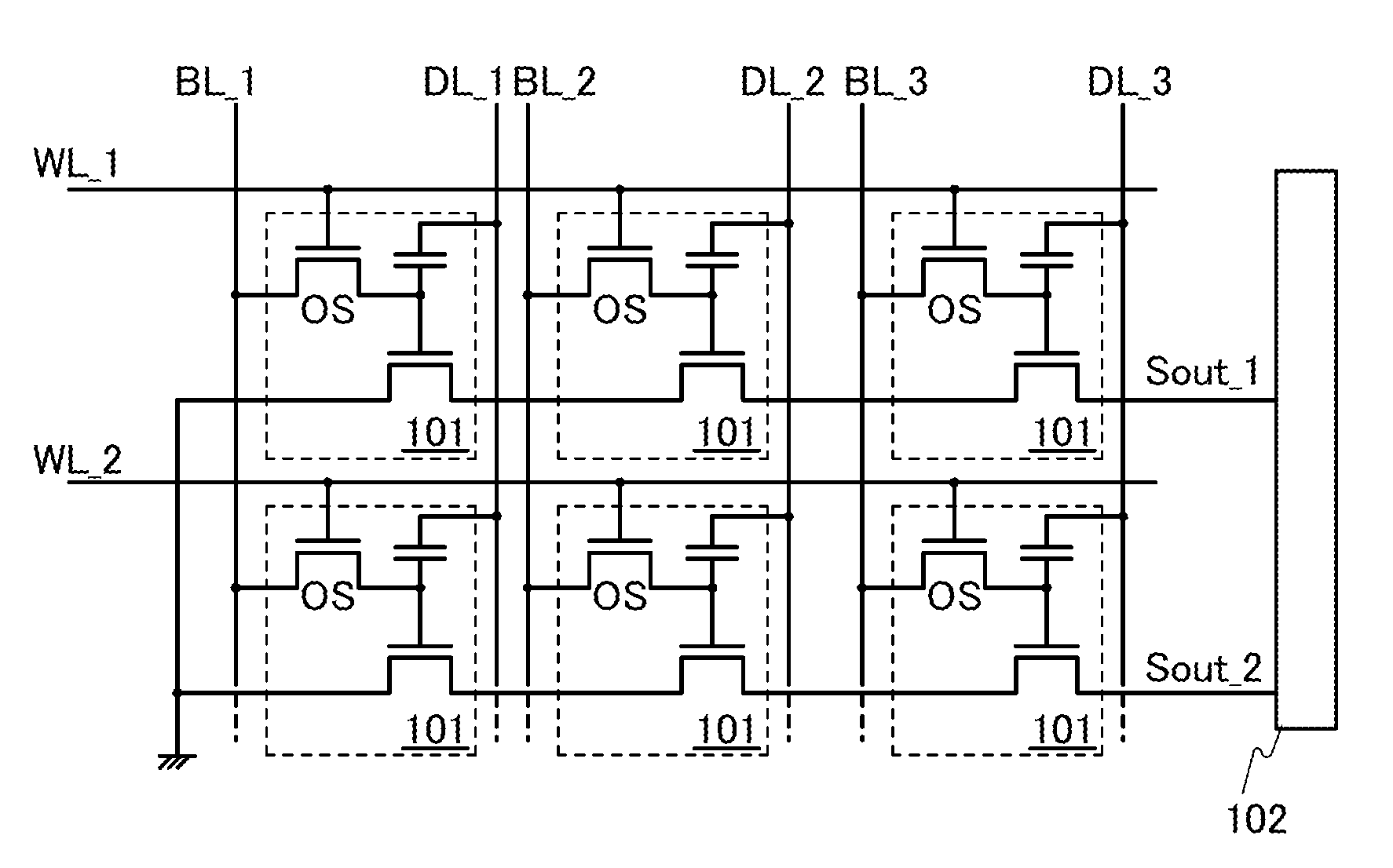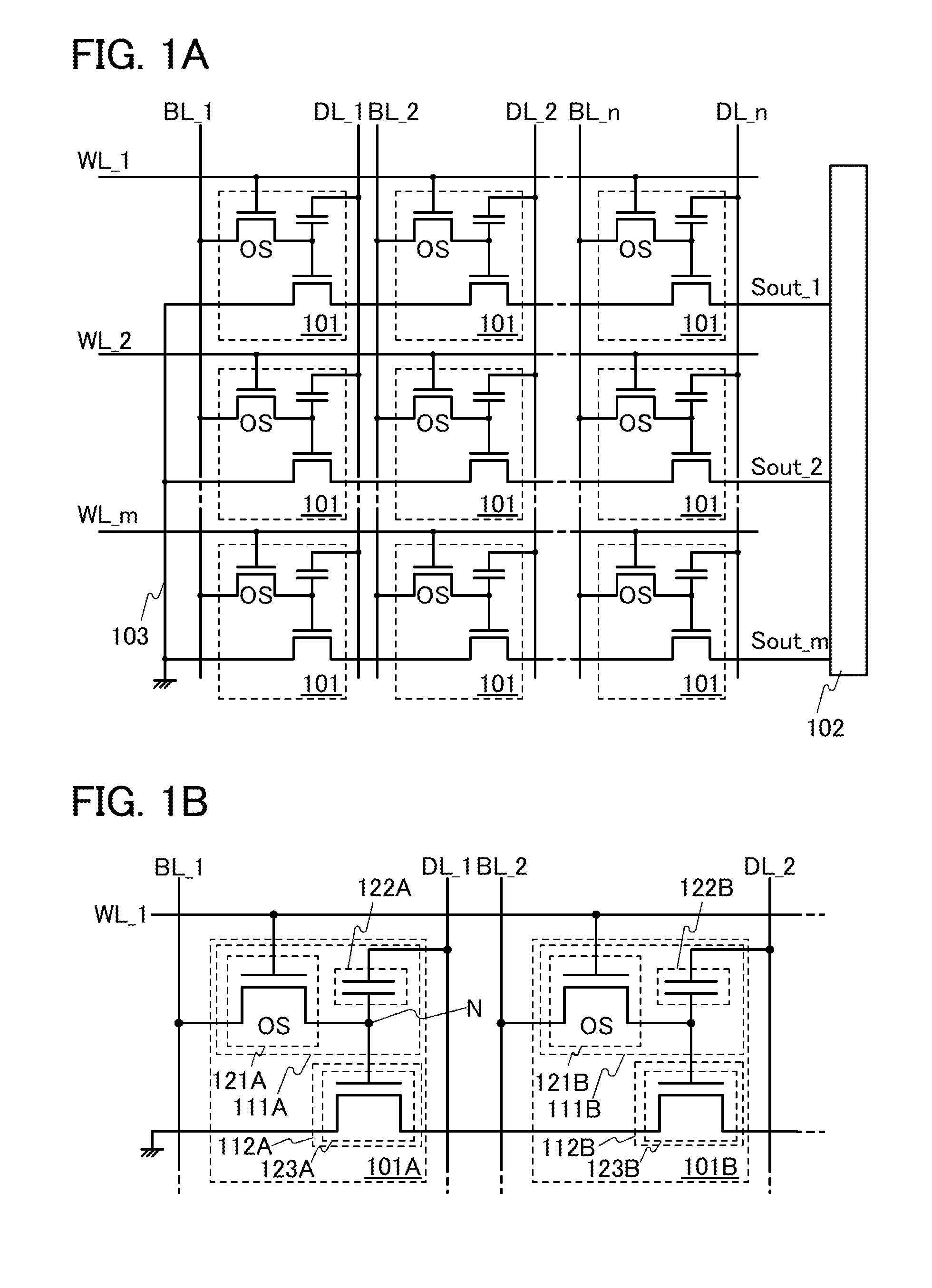Semiconductor memory device
- Summary
- Abstract
- Description
- Claims
- Application Information
AI Technical Summary
Benefits of technology
Problems solved by technology
Method used
Image
Examples
embodiment 1
[0041]This embodiment describes the structure of a semiconductor memory device that can act as a CAM with reference to FIGS. 1A and 1B.
[0042]FIG. 1A is a circuit diagram of a semiconductor memory device including m rows and n columns (m and n are natural numbers) of memory cells. The semiconductor memory device in FIG. 1A includes bit lines BL_1 to BL_n, word lines WL_1 to WL_m, data lines DL_1 to DL_n, a plurality of memory cells 101, and a determination circuit 102.
[0043]The memory cell 101 is connected to any one of the bit lines BL_1 to BL_n, any one of the word lines WL_1 to WL_m, and any one of the data lines DL_1 to DL_n. In addition, memory cells 101 are connected in the row direction, that is, the direction in which the word lines WL_1 to WL_m are extended. One terminal of each of output signal lines Sout_1 to Sout_m is connected to the determination circuit 102, and the other terminal is connected to a common power supply line 103 (a GND line in FIG. 1A).
[0044]The determin...
embodiment 2
[0066]This embodiment shows a specific structure of the semiconductor memory device in Embodiment 1 which can act as a CAM, and examples of the structure and operation of the semiconductor memory device with reference to FIG. 2, FIGS. 3A and 3B, FIGS. 4A and 4B, and FIGS. 5A and 5B.
[0067]FIG. 2 is a circuit diagram of a semiconductor memory device including two rows and three columns of memory cells, which is shown as an example of the semiconductor memory device in FIG. 1A. The semiconductor memory device in FIG. 2 includes bit lines BL_1 to BL_3, word lines WL_1 and WL_2, data lines DL_1 to DL_3, two rows and three columns of memory cells 101, and the determination circuit 102. Connections between each memory cell 101 and the lines, and the circuit configuration of the memory cells are similar to those in FIGS. 1A and 1B.
[0068]Next, a description is given with reference to FIGS. 3A and 3B of an operation for writing data to each row in the semiconductor memory device illustrated i...
embodiment 3
[0085]This embodiment shows a plurality of modes of the structure of the second transistor in the reference circuit described in Embodiment 1.
[0086]As described in the above embodiment, detection of the conducting state or nonconducting state of the second transistor enables high-speed data search. Therefore, unlike a semiconductor layer in the first transistor, a semiconductor layer in the second transistor can be formed using various materials.
[0087]For example, like FIG. 1A, FIG. 6A is a circuit diagram illustrating a configuration of a memory cell. FIG. 6A illustrates a first transistor 131, a capacitor 132, and a second transistor 133A. A semiconductor layer in the second transistor 133A can be formed using silicon.
[0088]Note that silicon for the semiconductor layer can be microcrystalline silicon, polycrystalline silicon, single crystal silicon, or the like. Note that in FIG. 6A, the second transistor 133A is represented by “Si” so that it is regarded as a transistor whose cha...
PUM
 Login to View More
Login to View More Abstract
Description
Claims
Application Information
 Login to View More
Login to View More - R&D
- Intellectual Property
- Life Sciences
- Materials
- Tech Scout
- Unparalleled Data Quality
- Higher Quality Content
- 60% Fewer Hallucinations
Browse by: Latest US Patents, China's latest patents, Technical Efficacy Thesaurus, Application Domain, Technology Topic, Popular Technical Reports.
© 2025 PatSnap. All rights reserved.Legal|Privacy policy|Modern Slavery Act Transparency Statement|Sitemap|About US| Contact US: help@patsnap.com



